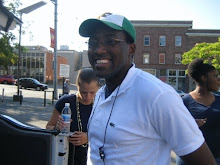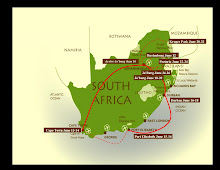Upon my return from South Africa my newspaper asked me to write a feature story about my big trip. Now that it can no longer be accessed on our Web site I am posting this July 11 feature in the Tallahassee Democrat onto my blog.
By Will Brown
It may have taken a soccer tournament to illuminate the world's perceptions of a continent.
Hundreds of thousands of tourists flooded South Africa over the past month to watch the World Cup. Action concludes today when Spain and the Netherlands meet in Johannesburg for the final at 2:30 p.m. on ABC.
The world's largest sporting event has allowed both the country and the continent to shed some misconceptions — chiefly, that it is a dark continent where depravity and despair dominate.
Americans made the journey more than fans and tourists from any other nation. To residents in the proud nation of 49 million people, it's those same Americans who are responsible for the stereotypes and connotations that are as much a part of the country's past as apartheid.
From Johannesburg to Durban to Cape Town, and in the many cities in between, South Africa is a country that definitely has its warts. That is undeniable, and its residents are up-front about them.
Across the country, South Africans possessed a genuine interest in having visitors go home with an accurate picture of their country — which is an incredibly diverse one with 11 official languages, a culture that tightropes between being Western and serving as the beating heart of Africa, and the only place where a visitor can see one World Heritage site after another.
Going solo to South Africa
Afraid I was going to be trounced playing the American version of football, my parents introduced me to soccer when I was 4 years old. They expressed a similar trepidation when I told them I wanted to travel to South Africa in June for the World Cup — alone.
After being challenged by a college professor to read Nelson Mandela's autobiography in 2007, I was determined to see the beautiful veld for myself during the World Cup. Reading Mandela's potent, yet simple, words empowered me to look beyond the surface and thus enter his country with a clean slate of opinions waiting to be freshly colored.
Years of saving and months of planning paid off when I touched down, without a hitch, in Johannesburg. The humbling thought of being on the African continent, especially as an African-American, was surreal. So much time was spent soaking up everything in front of me that I didn't even think about a World Cup tournament favorite when I stepped off the plane June 10.
Cape of cold
Cape Town is the city by the sea that instantly commands the attention of tourists with its spectacular views from atop Table Mountain, the historic District Six neighborhood that was leveled during apartheid, a vibrant nightlife scene and proximity to world-class wineries.
Cape Town turned out to be more exciting than residents had promised.
My sole reason for traveling to the city nicknamed "The Cape of Storms" was to see Robben Island, one of eight World Heritage sites in South Africa. Mandela was housed there for more than a quarter century because he had the audacity and courage to espouse the belief that South Africans should all be treated equally by a representative government.
Robben Island is 10 kilometers, or 6.2 miles, off the coast. Visiting this site is completely weather-dependent, as storms, especially in the winter, can whip up seas reaching 30 feet. The seas are actually warmer in the winter, as the swirling winds from the Indian and Atlantic Oceans push the summer waters out to sea.
Persistent rainfall and strong winds made visiting Robben Island an impossibility for me, but it did provide an opportunity to take a two-hour bus trip around the city and its nearby beaches.
The two-hour drive took visitors up to Table Mountain to view the unique and exotic flora that can be found nowhere else in the world. We were told there are more unique species of plants and trees in the Table Mountain National Park than in the entire British Isles.
Images from atop Table Mountain provided a reminder that whatever method one takes to get into Cape Town, it's always a good idea to have a camera in hand.
Any flight into the city will take travelers over the breathtaking landscape at a low enough altitude to appreciate the metropolis tucked between the mountains and the sea. Those traveling via car will have the great visual privilege of taking the scenic Garden Route.
The Garden Route, like the Autobahn in Germany or the Pacific Coast Highway in California, is one of those must-do-before-you-die drives. It's not one that can be made at night, however, as there are few interruptions, and fewer lights, along the road that took me from Cape Town to Port Elizabeth. Had I known about the Garden Route before I visited Cape Town, I would have scheduled my bus trip during the day.
Up the coast
Coastal cities such as Cape Town, Port Elizabeth and Durban have a more relaxed vibe than the rest of the country.
Port Elizabeth is colloquially called PE by residents and is the breeziest of the three. The busy port city along the Indian Ocean is the fifth-largest city in South Africa, but it retains the atmosphere of a cozy beach-side town.
Nelson Mandela Bay, which Port Elizabeth neighbors, is just as majestic as its namesake. The calm, clear waters extend beyond the horizon. Though not as popular with professional photographers as Cape Town beaches, the amateurs that filled the pier and braved biting winds to walk the beaches left with spectacular pictures.
Durban, a city of nearly5 million residents, billed itself as the "warmest place to watch the Word Cup." Residents and fellow tourists billed it South Africa's alternative to South Beach. The truth was somewhere in the middle, as this Indian-influenced city was warmer than the nine other host cities, and not nearly as flamboyant as Miami.
Winter did not deter people from getting into the water, where waves ran as high as 12 feet. The surf at Durban's multiple beaches was choppier than that at Port Elizabeth, but the trade-off was the fact that the water was warmer.
Nearly a fifth of Durban's residents are of East Indian descent. A century ago, the city was home to a young lawyer who returned to India to be the change he wished to see in the world. Mohandas K. Gandhi honed his legal skills in Durban, fighting injustice and racism before returning to India in 1915.
Perception versus reality
Durbanites are quite proud of their city and were very eager to show it off to the tourists from Spain, Brazil, the Netherlands and other soccer powers that were in town to watch their teams play.
Only Johannesburg residents were more vocal in correcting American opinions about such notions as wildlife roaming free in the streets, whether Africa was a "civilized" continent and safety in South Africa being substandard to other countries.
Johannesburg is like New York, London, Rio de Janerio, Jakarta, Tokyo or any other metropolis that's also the country's financial center. There are areas that are affluent and others where it's nothing short of stupid to walk alone flouting anything of value.
Tallahasseeans would appreciate the sheer amount of trees liberally scattered throughout the "City of Gold." Johannesburg has the largest urban forest in the world — the city has hundreds of parks and open spaces filled with jacaranda, oak, palm and pepper trees.
Home to the biggest soccer stadium in Africa, Johannesburg is also home to a wealth of cultural opportunities.
The Apartheid Museum in the Gold Reef City section of Johannesburg is a must for any visitor to South Africa. Taking photographs inside the museum is strictly prohibited, but the damning videos, pictures, propaganda and artifacts from that era of segregation and subsequent racial division will engrave images on the mind's eye more vivid than a 35-millimeter camera could capture.
Visitors should also take a township tour through Soweto. On the southwestern outskirts of the city, Soweto has been exploited by foreign media outlets for years to illustrate the depths of despair and depravity that many falsely presume exists throughout the entire country.
Soweto will never be confused with the upper class Sandton suburb, but it's a township that is not much different than some inner city or working class neighborhoods in the U.S.
This township of 4 million people features the best and worst of Johannesburg — and any description of the city that lacks both is decidedly inaccurate. There are some incredibly poor families that live in shanties, and there are others that live in brick homes with immaculate lawns.
Fitting conclusion
It's appropriate that the first World Cup held in Africa will also crown a new champion, as neither the Dutch nor the Spanish have won the tournament, after decades of fielding teams with the talent to do so. The orange of the Netherlands and the red of Spain that instantly come to mind whenever I saw someone from either country will stick with me.
When people were not attending soccer matches, they were watching them in bars, hostels, hotel lobbies or in the designated Fan Fest areas FIFA set up in the 10 host cities. During my 16 days in South Africa, only two did not include watching a match — as I even found a way to catch the Spain-Honduras match while out on a safari.
Watching Argentina demolish South Korea while flat on my back on a Durban beach under the bright sun and perfect weather was a highlight. As raucous as the atmosphere was at the first three U.S. matches I attended, the tranquility of enjoying a warm day, soccer and the beach was more than this native Floridian could have asked from a trip abroad.
Being in Pretoria for the American's dramatic — though completely unnecessary, if their matches had had competent refereeing — comeback against Algeria was a perfect conclusion to four distinct game atmospheres that surpassed my grandest expectations.
Fair or not, Africa's reputation was on the line at this World Cup. Soccer broadcasters would routinely speak of the South African squad and the five other African teams in the tournament as a collective.
If that is the method of judgment for the hosts of the 2010 World Cup, they surpassed all expectations and were a unique, and appropriate, host for the world's largest sporting event — vuvuzelas included.
Contact reporter Will Brown at 599-2172 or wbrown@Tallahassee.com.
Wednesday, July 21, 2010
Subscribe to:
Posts (Atom)


